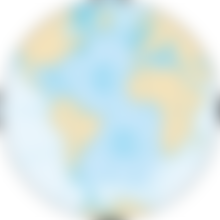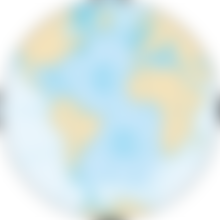The Atlantic Ocean is the second-largest of the world's oceans, with an area of about 106,460,000 km2 (41,100,000 sq mi).It covers approximately 20 percent of Earth's surface and about 29 percent of its water surface area. It separates the "Old World" from the "New World".
The Atlantic Ocean occupies an elongated, S-shaped basin extending longitudinally between Europe and Africa to the east, and the Americas to the west. As one component of the interconnected World Ocean, it is connected in the north to the Arctic Ocean, to the Pacific Ocean in the southwest, the Indian Ocean in the southeast, and the Southern Ocean in the south (other definitions describe the Atlantic as extending southward to Antarctica). The Equatorial Counter Current subdivides it into the North(ern) Atlantic Ocean and the South(ern) Atlantic Ocean at about 8°N.
The oldest known mentions of an "Atlantic" sea come from Stesichorus around mid-sixth century BC (Sch. A. R. 1. 211):Atlantikôi pelágei (Greek: Ἀτλαντικῷ πελάγει; English: 'the Atlantic sea'; etym. 'Sea of Atlantis') and in The Histories of Herodotus around 450 BC (Hdt. 1.202.4): Atlantis thalassa (Greek: Ἀτλαντὶς θάλασσα; English: 'Sea of Atlantis' or 'the Atlantis sea') where the name refers to "the sea beyond the pillars of Heracles" which is said to be part of the sea that surrounds all land.
In these uses, the name refers to Atlas, the Titan in Greek mythology, who supported the heavens and who later appeared as a frontispiece in Medieval maps and also lent his name to modern atlases.On the other hand, to early Greek sailors and in Ancient Greek mythological literature such as the Iliad and the Odyssey, this all-encompassing ocean was instead known as Oceanus, the gigantic river that encircled the world; in contrast to the enclosed seas well known to the Greeks: the Mediterranean and the Black Sea. In contrast, the term "Atlantic" originally referred specifically to the Atlas Mountains in Morocco and the sea off the Strait of Gibraltar and the North African coast. The Greek word thalassa has been reused by scientists for the huge Panthalassa ocean that surrounded the supercontinent Pangaea hundreds of millions of years ago.
The term "Aethiopian Ocean", derived from Ancient Ethiopia, was applied to the Southern Atlantic as late as the mid-19th century.
During the Age of Discovery, the Atlantic was also known to English cartographers as the Great Western Ocean.
The term The Pond is often used by British and American speakers in context to the Atlantic Ocean, as a form of meiosis, or sarcastic understatement. The term dates to as early as 1640, first appearing in print in pamphlet released during the reign of Charles I, and reproduced in 1869 in Nehemiah Wallington's Historical Notices of Events Occurring Chiefly in The Reign of Charles I, where "great Pond" is used in reference to the Atlantic Ocean by Francis Windebank, Charles I's Secretary of State.
The International Hydrographic Organization (IHO) defined the limits of the oceans and seas in 1953,but some of these definitions have been revised since then and some are not used by various authorities, institutions, and countries, see for example the CIA World Factbook. Correspondingly, the extent and number of oceans and seas vary.
The Atlantic Ocean is bounded on the west by North and South America. It connects to the Arctic Ocean through the Denmark Strait, Greenland Sea, Norwegian Sea and Barents Sea. To the east, the boundaries of the ocean proper are Europe: the Strait of Gibraltar (where it connects with the Mediterranean Sea—one of its marginal seas—and, in turn, the Black Sea, both of which also touch upon Asia) and Africa.
In the southeast, the Atlantic merges into the Indian Ocean. The 20° East meridian, running south from Cape Agulhas to Antarctica defines its border. In the 1953 definition it extends south to Antarctica, while in later maps it is bounded at the 60° parallel by the Southern Ocean.

The Atlantic has irregular coasts indented by numerous bays, gulfs and seas. These include the Baltic Sea, Black Sea, Caribbean Sea, Davis Strait, Denmark Strait, part of the Drake Passage, Gulf of Mexico, Labrador Sea, Mediterranean Sea, North Sea, Norwegian Sea, almost all of the Scotia Sea, and other tributary water bodies.
Including these marginal seas the coast line of the Atlantic measures 111,866 km (69,510 mi) compared to 135,663 km (84,297 mi) for the Pacific.
Including its marginal seas, the Atlantic covers an area of 106,460,000 km2 (41,100,000 sq mi) or 23.5% of the global ocean and has a volume of 310,410,900 km3 (74,471,500 cu mi) or 23.3% of the total volume of the earth's oceans. Excluding its marginal seas, the Atlantic covers 81,760,000 km2 (31,570,000 sq mi) and has a volume of 305,811,900 km3 (73,368,200 cu mi). The North Atlantic covers 41,490,000 km2 (16,020,000 sq mi) (11.5%) and the South Atlantic 40,270,000 km2 (15,550,000 sq mi) (11.1%).
The average depth is 3,646 m (11,962 ft) and the maximum depth, the Milwaukee Deep in the Puerto Rico Trench, is 8,376 m (27,480 ft)
Humans evolved in Africa; first by diverging from other apes around 7 mya; then developing stone tools around 2.6 mya; to finally evolve as modern humans around 100 kya. The earliest evidence for the complex behavior associated with this behavioral modernity has been found in the Greater Cape Floristic Region (GCFR) along the coast of South Africa. During the latest glacial stages, the now-submerged plains of the Agulhas Bank were exposed above sea level, extending the South African coastline farther south by hundreds of kilometers. A small population of modern humans — probably fewer than a thousand reproducing individuals — survived glacial maxima by exploring the high diversity offered by these Palaeo-Agulhas plains. The GCFR is delimited to the north by the Cape Fold Belt and the limited space south of it resulted in the development of social networks out of which complex Stone Age technologies emerged.Human history thus begins on the coasts of South Africa where the Atlantic Benguela Upwelling and Indian Ocean Agulhas Current meet to produce an intertidal zone on which shellfish, fur seal, fish and sea birds provided the necessary protein sources.The African origin of this modern behaviour is evidenced by 70,000 years-old engravings from Blombos Cave, South Africa.
It a very beautiful ocean in the world.

Intresting article dear...